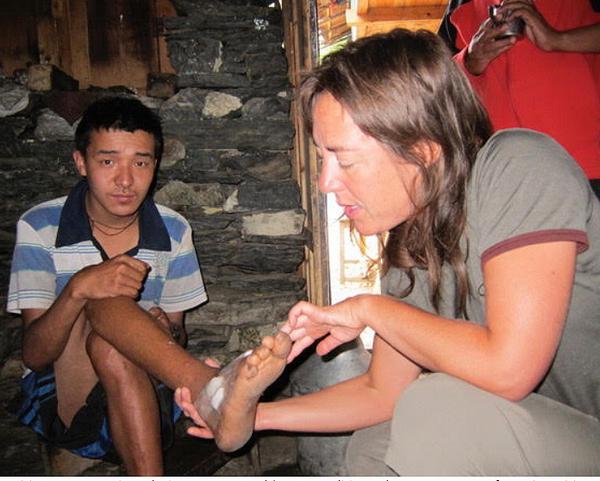
WASHINGTON, DC, February 15, 2024 (ENS) – The U.S. Food and Drug Administration has approved a new drug – an injection to treat severe frostbite in adults that reduces the risk of finger or toe, nose or ear amputation. The iloprost injection, marketed under the brand name Aurlumyn, is a vasodilator, a drug that opens blood vessels and prevents blood clotting.
“This approval provides patients with the first-ever treatment option for severe frostbite,” said Norman Stockbridge, M.D., Ph.D., director of the Division of Cardiology and Nephrology in the FDA’s Center for Drug Evaluation and Research.
“Having this new option provides physicians with a tool that will help prevent the lifechanging amputation of one’s frostbitten fingers or toes,” Dr. Stockbridge said.
The drug iloprost, originally developed by the California company CoTherix, won an FDA approval in 2004 to treat pulmonary arterial hypertension, a life-threatening illness with abnormally high blood pressure in the arteries between the heart and lungs. Known commercially as Ventavis, it was then the only inhaled therapy for the disease in the United States.
Eicos Sciences, a wholly-owned subsidiary of Maryland-based CiVi Biopharma, has reformulated iloprost into an injection. Eicos has been developing it to treat frostbite since the company was founded in 2017, and was successful in winning FDA approval on Valentine’s Day.
The FDA granted the approval to market Aurlumyn to San Francisco-based Actelion Pharmaceuticals US, Inc., a Johnson & Johnson company treating pulmonary arterial hypertension with other FDA approvals already on file.
Iloprost has been used to treat severe frostbite in other parts of the world such as Canada, Nepal and Europe, for years.
Dr. Monica Piris, who was not associated with any company or institution mentioned here, has seen a lot of frostbite over her 20 Himalayan trips as an expedition doctor, 10 of them to Mount Everest Base Camp.
“In my personal opinion, losing a digit to frostbite is a sign that something went horribly wrong on a climb,” she told ExplorersWeb. “I would never call a climb a success if the climber sustained frostbite.”

Frostbite can occur in stages, ranging from mild frostbite that does not cause permanent skin damage, to severe frostbite when both the skin and underlying tissue are frozen and blood flow is stopped, sometimes requiring amputation.
Iloprost’s effectiveness in treating severe frostbite was established in an open-label, controlled trial that randomized 47 adults with severe frostbite into one of three treatment groups.
Group 1 received iloprost intravenously for six hours daily for up to eight days. The two other groups received other medications that are not approved for frostbite, given with iloprost to those in Group 2, and given without iloprost to people in Group 3. All 47 received aspirin by vein as well as standard care,
The primary measure of iloprost’s effectiveness were bone scans of the 47 subjects obtained seven days after initial frostbite. That was used to predict the need for amputation of at least one finger or toe.
On day seven, the bone scan finding predictive of the need for amputation was observed in 0% (0 of 16) patients receiving iloprost alone (Group 1) compared to 19% (3 of 16) patients in Group 2 and 60% (9 of 15) patients in Group 3.
The presence of the bone scan abnormality was “significantly lower in the two groups receiving iloprost.” Most patients had follow-up information on whether they subsequently underwent at least one finger or toe amputation. The need for amputation was consistent with the bone scan findings, the authors report.
The most common side effects of Aurlumyn include headache, flushing, heart palpitations, fast heart rate, nausea, vomiting, dizziness, and blood pressure that is too low.
Thousands Suffer Frostbite in Winter
The overall incidence of frostbite injury in the United States is 0.83 of every 100,000 people.
Frostbite, caused by freezing, leads to a loss of feeling and color in the body parts it affects, usually extremities – the nose, ears, cheeks, chin, fingers, and toes. Frostbite can permanently damage the body, and severe cases can lead to amputation.
Frostbite affects military personnel operating in cold regions, industrial, agricultural and fishery workers, people experiencing homelessness, as well as people enjoying recreational activities such as skiing, snowboarding, hiking, mountaineering, and ice climbing.
Frostbite occurs more often in men than women and decreases in frequency over the age of 65. Individual factors that increase frostbite risk are diabetes, white fingers in the cold, cardiac insufficiency, angina pectoris, stroke, depressive feelings, and heavy alcohol consumption.
Homeless People Most Likely to Lose Body Parts
On November 24, 2021 two Minneapolis surgeons published a study of frostbite injuries in the United States that shows, “Of the social factors associated with frostbite injury, homelessness and the black race were independently associated with a higher likelihood of amputation at the primary admission” to hospitals.”
The study’s authors Dr. Frederick W. Endorf and Dr. Rachel Nygard are surgeons affiliated with Hennepin Healthcare-Minneapolis in Minnesota. They write, “Severe frostbite injury can result in significant disability from amputation of limbs and digits which may be mitigated through prompt medical care.”
Their study reflects their concern for homeless frostbite patients, especially those in Minneapolis, where the temperature bottomed out at -13° F on February 3, 2023, and -8 °F on January 11, 2024.
“Homeless frostbite patients were more frequently discharged against medical advice and were less likely to discharge with supportive medical care, despite having a higher rate of more severe injury,” wrote Drs. Endorf and Nygard. “Disability from amputation following frostbite injury affects at least 20% of frostbite-injured patients and disproportionally affects the homeless population.”
Their study was published by Oxford University Press on behalf of the American Burn Association. Now, Drs. Endorf and Nygard are calling for further study “to ascertain the decision making that leads to early amputation following frostbite injury, especially in the homeless and black population.”
They advise, “Outreach and education efforts should be initiated to promote salvage of functional limb length following frostbite injury.”
They might find Aurlumyn helpful.
Featured image: Snowboarder John Hammond makes a turn at Alpine Meadows, Lake Tahoe, California, June 7, 2013 (Photo by Ripley119)

